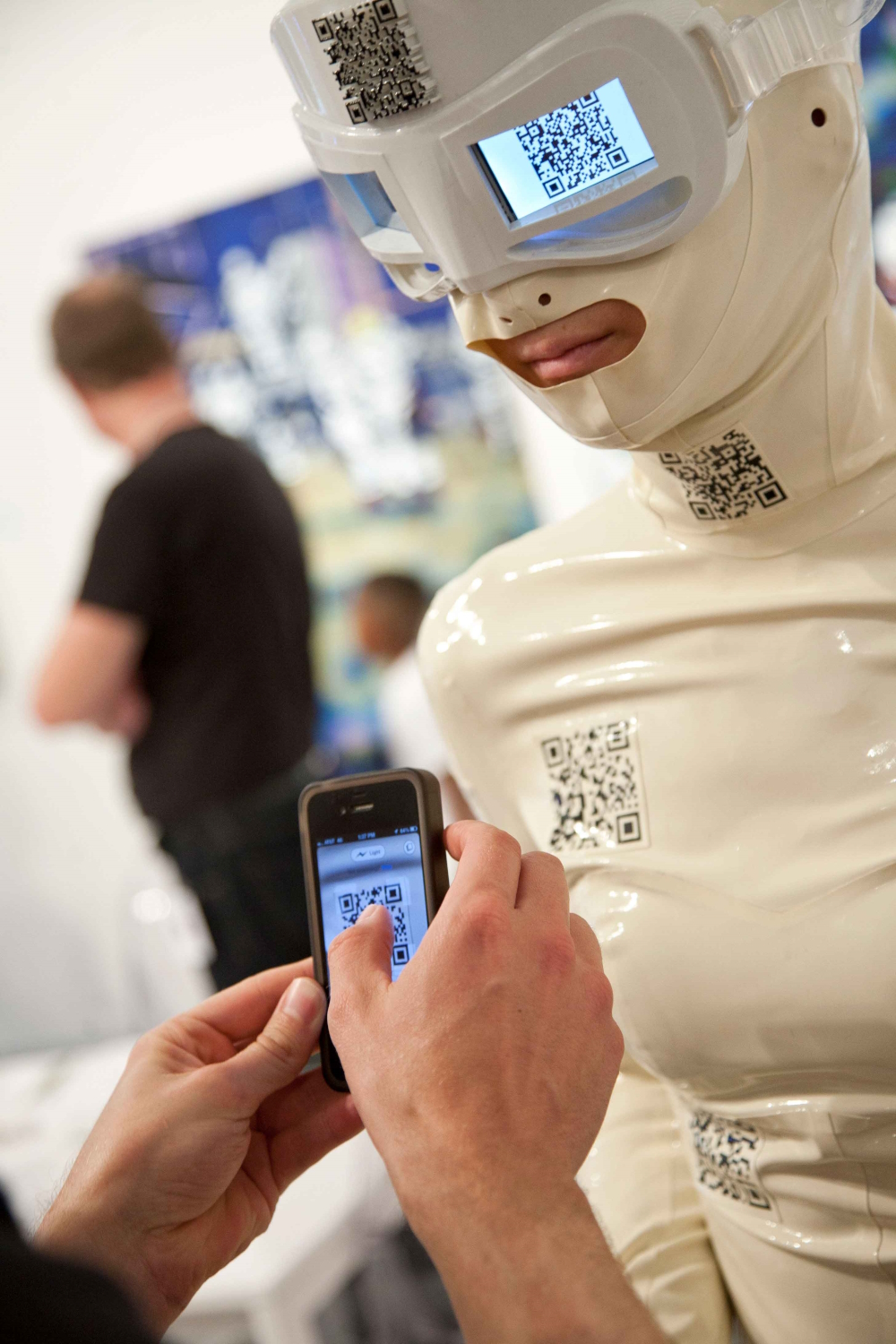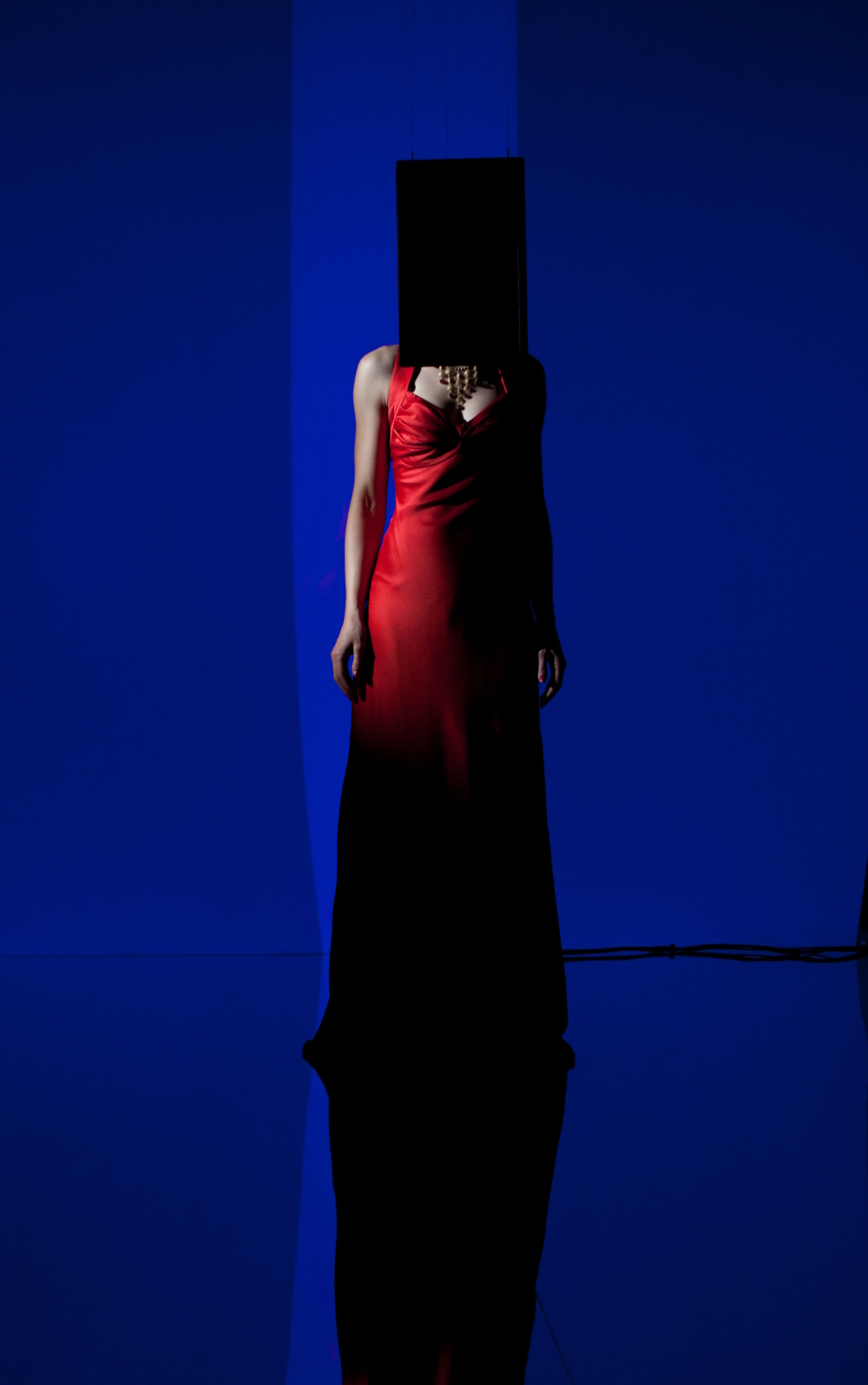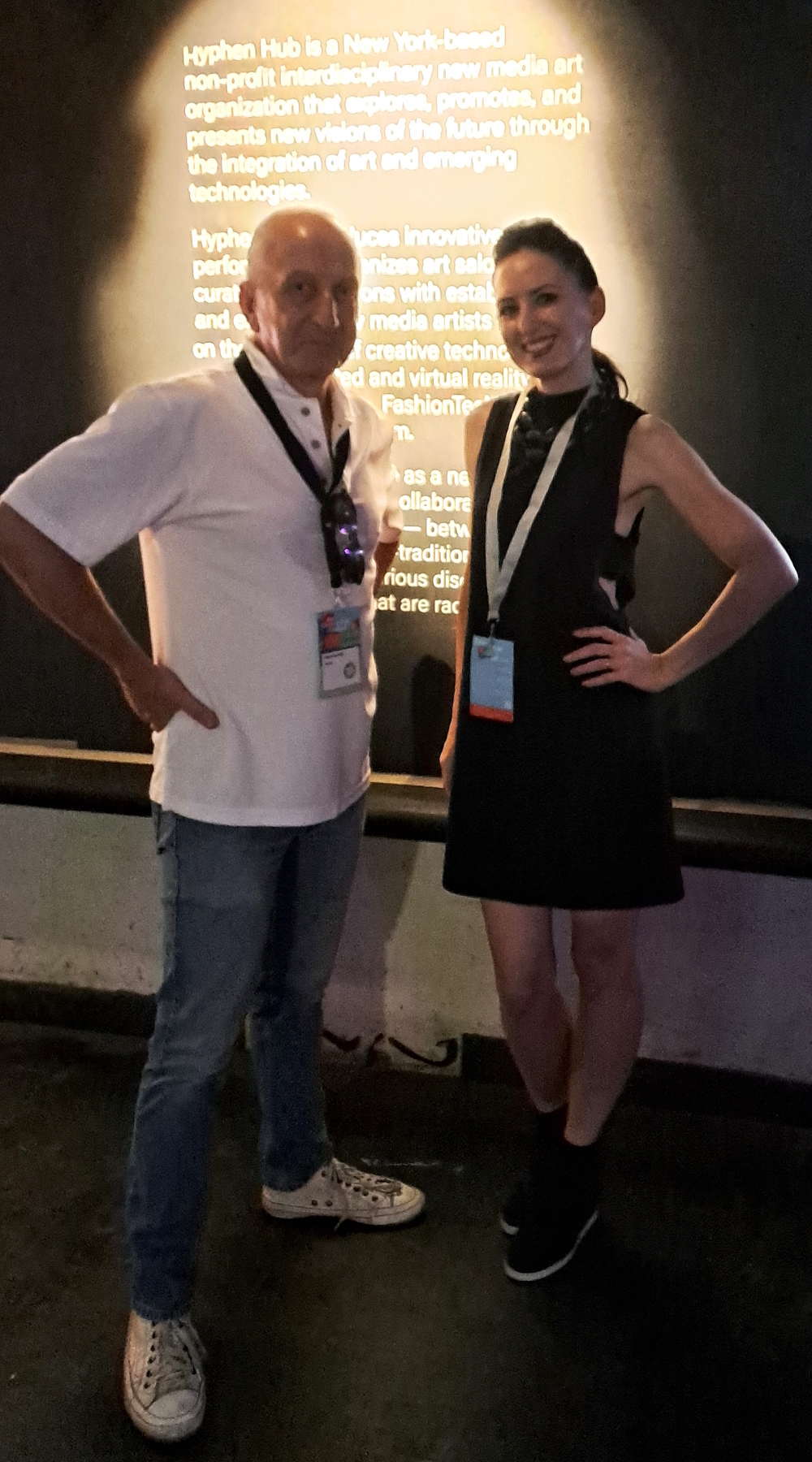Tiffany Trenda
awarded new media Performance Artist
US
How are people changing within a culture that’s being shaped by increasingly integrated computation? What does it mean to be human in a world that’s constantly shifting between the physical and the simulated? How do such experiences impact our intimacy, memory, and senses? Core questions as such are explored by this creative with each new project. Her search for clues takes place worldwide – be it at the World's Fair in Shanghai, CONTEXT Art Miami, Laboratorio Arte Alameda in Mexico City, Faena Art Center in Buenos Aires, Art Center Nabi in Seoul, Barbican in London, Times Square in New York, or during the Venice Biennale. The lady‘s performances in which, "she interchanges her identity and her physical body with screens to represent how we conceal and reveal ourselves through our devices (smart phones, computers)“ (womeninphotography.org) are futuristic as well as unique. They secured her various honors including being named ‚Artist of the Year‘ at the London International Creative Competition Awards! The American‘s artistic field of activity provides an insight into tomorrow today.
Tiffany Trenda
awarded new media Performance Artist
US

Science fiction becomes reality when Tiffany Trenda appears for an interactive performance in one of her interactive garments. There she is „transforming herself into living, sentient sculptures through wearables, including screens“ (laweekly.com).
Tiffany Trenda (* March 1979 in Los Angeles) began her career studying photography and installation at Art Center College of Design in Pasadena/California from 1998 to 2002, finishing with a BFA. From 2009 to 2011 she was at UCLA‘s Design and Media Arts and left with a MFA.
Her first public show as an artist, a collaborative performance, took place at Bergamot Station Santa Monica, California in 2001. Since then she has staged numerous media art projects that connect technology and art. In Body Code (2012), Tiffany Trenda "explores the relationship between the human body, particularly the female body, and technology“ (artcenter.edu). "Interchanging her identity with screens, she shows how devices have become an integral part of our daily lives, almost a second skin, altering the way we form memories and interact with the outside world.“
For Proximity Cinema (2013) she wore her signature design element, the full-body vinyl suit construction, this time with approximately 38 embedded cell phone screens. The viewer could see the part of the skin that was touched prior. Through this a distant visual pleasure converged with the direct personal contact.
Ubiquitous States (2015) is a 3D costume that synchronises heartbeats through touch and sound to probe deeper complexities of human emotions. "Trenda donned a 3D printed dress that has an embedded computer screen", notes cocaproject.art. "The image on the screen will show a data visualization of both the participant’s and Trenda’s heartbeat. During the performance, the artist will approach a spectator and place a heart monitor (located at Trenda’s fingertip inside the glove) on the viewer’s wrist. Once the sensor reads the pulse of the user, the imagery on the screen will change and show both pulses simultaneously. Trenda and the viewer will try and match their rhythms.“ So the performance questions, if we can have authentic human connections using today’s technology.
The Vanishing Portrait (2019) was a commissioned work and is now in the permanent collection of the Scottsdale Museum of Contemporary Art. The project explores the discrimination of women’s bodies in technology. It comments on a specific bias in today’s social media and other online platforms“ (lacda.com).
Un/Seen (2021), was a commissioned work by Building Bridges Art Exchange, and is a live performance within an immersive experience. It transforms in real-time and is a hybrid of holographic, physical, and animation. “All of this, while I am in another location not on-site“, Tiffany Trenda explained in an interview with the LA Weekly. „The performance comments on how new immersive experiences create disembodiment. That is, we are physically in one space while our eyes and thoughts are experiencing another world simultaneously. Our bodies become dissociated as we shift between the simulated and the real. Furthermore, we are not immediately within the presence of another. Our presence is mediated and transported into another space that doesn’t actually exist. We are in essence, seen and unseen.“
“Everyone is more interested in their phones. They are not looking at me, an actual live person. They’re scanning; they’re taking video; they’re taking pictures; and the piece is centered on how we’re creating memories now, through screens. How does that affect us? We don’t remember things live any more. Now we see things in the past through a veil. And that’s how we’re seeing and experiencing the world -- it’s all through screens” (kcet.org).
In Trenda’s work “It’s about that connection…and with performance art, you have to be there to experience it” (playboy.com).
Tiffany Trenda, who co-founded the Los Angeles Art Collective in March 2014, is married to Julian Navarro (a director and producer of art fairs), mother of a son Maximus, and based in Los Angeles, California.
Interview September 2023
Human-to-machine-interaction: Investigating the relationship between the body and technology through wearable media
INTUITION/IMAGINATION
?: How does intuition present itself to you – in form of a suspicious impression, a spontaneous visualisation or whatever - maybe in dreams?
Intuition holds a significant role in the art-making process. Personally, for me, ideas flow to me spontaneously, forming vivid mental images. At that point, I evaluate whether they merit further exploration.
?: Will any ideas be written down immediately and archived?
These visual pictures are then drawn out, described in writing, and sometimes accompanied by diagrams. I maintain an idea journal. Some are promptly explored, while others are revisited in a later time.
?: How do you come up with good or extraordinary ideas?
I don't actively chase after ideas; instead, they discover me. Good ideas may originate in the mind, but exceptional ones resonate in the gut.
?: Do you feel that new creative ideas come as a whole or do you get like a little seed of inspiration that evolves into something else and has to be realized by endless trials and errors in form of constant developments until the final result?
Ideas remain just fragments, “little seeds”, until transformed into tangible reality. This transformation requires diligent research and experimentation. Here, ideas undergo profound changes, evolving into something more captivating or potent. As artists, it's imperative that we welcome change and remain unafraid of mistakes, as sometimes, these errors make the most remarkable creations. To do so, we must retain a childlike curiosity, continuously exploring materials and ideas with an open mind.
?: What if there is a deadline, but no intuition? Does the first fuel the latter maybe?
My productivity thrives under the pressure of a deadline. Therefore, in the absence of one, I take the initiative to establish my own.
INSPIRATION
?: What inspires you and how do you stimulate this special form of imaginativeness?
Fashion, dance, movement, art, captivating environments, intriguing textures, and the continually evolving realm of technology are all abundant sources of my creative inspiration.
Most often, it's the everyday technologies that inspire me and spark new ideas. I ponder how these devices might interfere with our innate connection to our bodies and the world surrounding us. Our technologies serve as mirrors, reflecting the desires and necessities of our contemporary society. Yet, paradoxically, they can create boundaries, estranging us from our authentic selves and our links to the external world. This intricate interplay among society, technology, and our physical and emotional reactions serves as the driving force behind my creative pursuits.
?: How do you filter between ideas that are worthwhile pursuing and bad ones that you just let go of?
I don't believe in a clear-cut distinction between "bad" and "good" ideas. Instead, I see ideas as concepts that may not necessarily fit the current moment, require transformation, or can serve as the seeds for other creative endeavors. To me, it's all about evolution, viewing ideas as malleable clay that can be shaped into something meaningful.
?: Does an idea need to appeal to you primarily or is its commercial potential an essential factor?
My ideas are driven by the message I want to convey. In my performance work, the primary aim is to create art for non-commercial purposes, emphasizing the purity of artistic expression. Occasionally, I engage in collaborations with tech companies to facilitate the production of my work, but their involvement isn't the central focus of my creative goals.
?: Do you revisit old ideas or check what colleagues or competitors are up to at times?
I don't perceive myself as having direct competitors, as my work is highly distinctive. Nevertheless, I place great value on remaining current and engaging in meaningful dialogues with my artistic peers. The exchange of ideas among us enriches our artistic journeys, fostering inspiration and growth.
In terms of "old ideas," I occasionally revisit concepts that I conceived long ago. However, I transform them to make them more relevant in the present context. My creations, in essence, are a fusion of various ideas and a wellspring of inspiration from diverse sources.
CREATIVITY
?: What time or environment best suits your creative work process — for example, a time and place of tranquility or of pressure? Which path do you take from theory or idea to creation?
I excel when working under the pressure of a deadline. The environment that I create is sometimes completely silent or with music. That depends on the project and how I feel. I also require solitude and a lack of distractions to perform at my peak. A clean and organized workspace is essential for me, as I don't function well amidst chaos and clutter.
?: What’s better in the realization process — for example, speed and forcing creativity by grasping the magic of the moment or a slow, ripening process for implementation and elaboration?
This all depends upon the project and the deadline. Sometimes I need to force the creativity to meet a certain deadline. You just have to make it work! Other times, I take more time to let the work develop.
?: How important are self-doubt and criticism by others during such a process?
Self-doubt has no place in the creative process. If you doubt your abilities as an artist, you'll find yourself trapped in a never-ending cycle of self-sabotage. Nevertheless, there are methods to enhance your work, refine your approach, and increase efficiency. Seeking input from others, bouncing ideas off them, and viewing your work from different perspectives can be immensely beneficial.
?: Is it better to be creative on your own, to trust only your own instincts, or to work in a team?
The nature of the project dictates my approach. Certain projects demand a collaborative team effort with various expertise, especially when I'm delving into diverse technologies. On the other hand, there are projects where I work by myself.
?: In case of a creative block or, worse, a real failure, how do you get out of such a hole?
There are instances when I encounter a blockage, and the best course of action is to step away from it. During such moments, it's refreshing to engage in activities completely unrelated to my work. Whether it's finding serenity in a peaceful place or simply indulging in a fun activity that brings laughter, I often discover that the solution to any creative dilemma becomes clearer. It's as though I approach the problem from a fresh perspective, an entirely different angle.
?: Should a creative person always stay true to him- or herself, including taking risks and going against the flow, or must the person, for reasons of commercial survival, make concessions to the demands of the market, the wishes of clients and the audience’s expectations?
I have come to recognize that artists also need to sustain themselves. This occasionally necessitates adjustments in how one approaches their creative work. It doesn't imply "selling out"; instead, it entails an understanding of how your work can be presented and utilized in a manner that appeals to a broader audience. In essence, artists must be adaptable and capable of creating pieces that can be appreciated universally. It is also an understanding of who your audience is and how your work is being perceived and in what context.
?: How are innovation and improvement possible if you’ve established a distinctive style? Is it good to be ahead of your time, even if you hazard not being understood?
Cultivating a distinct style is crucial. It prevents you from looking like every other artist out there. While being ahead of your time is commendable, it's also essential to ensure that your artistic expression can be comprehended and appreciated by others.
?: When does the time come to end the creative process, to be content and set the final result free? Or is it always a work-in-progress, with an endless possibility of improvement?
Typically, the deadline marks the end of a project. Nevertheless, there's always room for enhancement. In my performance work, there are often multiple phases, starting with a prototype and culminating in a final rendition. I continue refining it and occasionally, I create multiple iterations for a single piece. It's an ongoing process dedicated to constant improvement.
?: Do you have a clue why do you do what you do the way you do it?
The distinctive nature of my work comes from years of experience in diverse artistic endeavors, including installation, dance, video, photography, performance, and painting. This amalgamation has given rise to a truly unique and multifaceted form of art. At its core, my creative process is fueled by passion and a meticulous attention to detail.
SUCCESS
?: “Success is the ability to go from one failure to another with no loss of enthusiasm.“ Do you agree with Winston Churchill’s quote?
Yes I resonate with Winston Churchill's quote, that success is driven by passion and failures are apart the journey.
?: Should or can you resist the temptation to recycle a ‘formula’ you're successful with?
No, you shouldn't necessarily resist the temptation to recycle a successful "formula." Some artists excel by being consistent, becoming masters of that one thing. It's indeed rewarding to create something that resonates with people. However, if you find yourself sticking to a single formula, don't hesitate to experiment with different approaches and make changes. This practice ensures that your work remains fresh and avoids becoming repetitive. On the other hand, artists like myself often explore a variety of techniques, materials, or, in my case, technologies. Perhaps, it comes from wanting to learn new things.
?: Is it desirable to create an ultimate or timeless work? Doesn’t “top of the ladder” bring up the question, “What’s next?” — that is, isn’t such a personal peak “the end”?
For me, the objective isn't to create a definitive or ultimate work. There's no finite endpoint or defining piece; it's all about constantly asking, "How can I improve it?" In my artistic practice, I'm perpetually engaged in diverse endeavors, utilizing various materials and technologies. I perform in a multitude of locations worldwide, and every performance is a unique experience. The audience's reactions vary depending on the setting, and this diversity is what fuels my artistic creation. It's the ever-changing interaction with different people and cultures that keeps me inspired. The unpredictable responses individuals have to body art and technology continuously astonish me. It's an ongoing journey of discovery and exploration, devoid of a predetermined conclusion.
MY FAVORITE WORK:
The most renowned and representative work is Body Code, an ongoing project that has spanned over a decade and continues to evolve. Over the years, Body Code has responded to the ever-changing landscape of the internet. The central theme revolves around the concept of reestablishing a meaningful connection with our physical selves and the world around us in an era of abundant online data. During the performance, the audience scans my body using their smart device to reveal information related to both the human body and the web.
In more recent developments, I've integrated ChatGPT into the project to engage in a dialogue with the AI program. Together, we explore questions concerning the human body and the impact of artificial intelligence on our understanding of it. We ponder whether AI can be a trustworthy source of information regarding the human body or if it has the potential to propagate inaccuracies, akin to a mere recorder echoing false data. This inquiry leads to the fundamental question: Where does the truth about the human body reside, and who holds the authority to define it?
The project website is: https://www.bodycodeart.com









